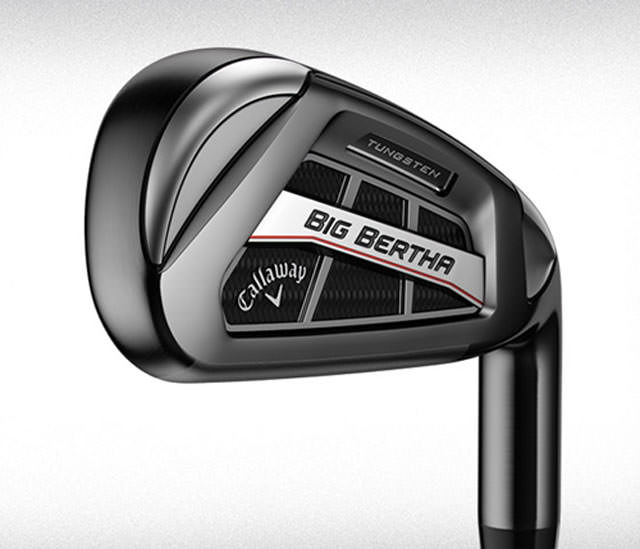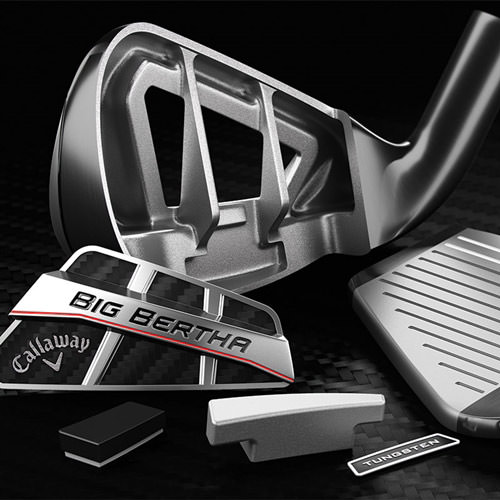An Iron Game Game-Changer

Vertical stiffness sounds pretty painful to a golfer with back issues, but it’s exactly what Callaway’s R&D department was looking for when designing the Callaway Big Bertha OS iron that hit pro shops last week.
Vertical stiffness, says Dr. Alan Hocknell, Callaway’s Senior VP of R&D, is the rigidity of the back of the iron during impact – the greater the iron’s vertical stiffness the more consistently it performs.
Hocknell and his team achieved superior vertical stiffness with the Big Bertha OS’s rather complex-looking structure called the Exo-Cage. No matter how stiff or rigid the back of the iron remained, though, the Exo-Cage would not benefit golfers if it were too heavy.

But by hollowing out the transition area between the hosel and face (an area that is usually solid in irons), Callaway saved significant discretionary weight, enabling the manufacturer to position tungsten weights (roughly 100g throughout the set) in various places to optimize the center of gravity for each iron.
“In the long irons, we want a lower center of gravity and a higher launching characteristic,” says Hocknell. “But we didn’t want that to carry all the way through the set, as even golfers who need the most help in the Super Game Improvement category can hit 8-irons and 9-irons fairly reliably and don’t want to hit high, floaty shots.”
So, he says, “we moved the tungsten further up the iron to create a high-spinning, lower-launching characteristic. The shape, scale and size of the irons also changes with the most help coming in the longer irons. The short irons, meanwhile, are not super over-sized and too clunky to be scoring clubs.”
Another feature of the Big Bertha OS is the Face Cup, which was part of the original Big Bertha iron, launched in 2014. Thanks to two additional years of research and experimentation, Callaway has succeeded in making the new Face Cup’s perimeter thinner than its predecessor’s, which allows a greater area of the face to be flexible and more dynamic, says Hocknell. “That effectively increases both the sweetspot size and peak ball-speed,” he adds.

The launch of the Big Bertha OS comes just two months after the introduction of the Steelhead XR. According to Callaway’s Senior Global Strategy Director for Fitting and Irons, Luke Williams, Callaway irons now cover “all golfers no matter what they are looking for, or what type of player they are.”
(Although not every single golfer can be compartmentalized into definite iron categories, Callaway’s line basically comprises the Big Bertha OS and XR for super game-improvement, the Steelhead XR and Apex CF 16 for game-improvement, and Apex Pro 16 and Apex Muscleback Irons for better players.)
While the Steelhead XR retails at $800, the Big Bertha OS costs $300 more—a reflection, says Williams, of the materials used and complexity of the manufacturing process. “The Exo-Cage and tungsten inserts contribute to the Big Bertha OS’s higher price point,” he adds.
A lighter version of the Big Bertha OS with extra loft is also available for seniors and ladies.

$1,100 with True Temper Speed Step 80 steel shaft.
$1,300 with UST Mamiya Recoil ES 460 graphite shaft.
RELATED:
Stylin’: Ping’s new iBlade is one good-looking club
Colorado AvidGolfer is the state’s leading resource for golf and the lifestyle that surrounds it, publishing eight issues annually and proudly delivering daily content via coloradoavidgolfer.com. Follow us on Twitter, Facebook and Instagram.
Leaving Negative Thoughts Behind when You Head to the Tee Box
How does worrying impact our golf performance? What strategies can we use to manage it?
All in the Family Meal
The secret ingredient of Colorado golf course success is well-fed caddies, cooks and groundskeepers
CSU Grad Davis Bryant Discusses His Rise as a Pro Golfer
Colorado State grad Davis Bryant opens up on his path to the pros and what keeps him busy when he’s off the course


